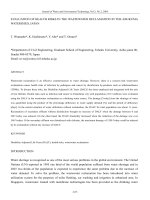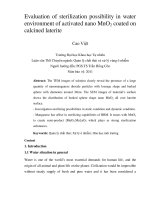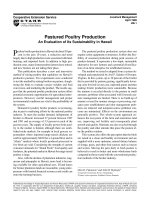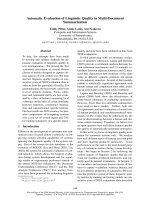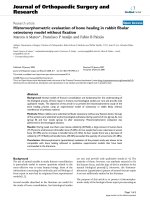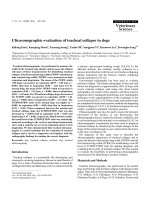Evaluation of combination of different methods for determination of activity of radioactive waste in sealed drum
Bạn đang xem bản rút gọn của tài liệu. Xem và tải ngay bản đầy đủ của tài liệu tại đây (344.15 KB, 7 trang )
Số 36 năm 2012
Tạp chí KHOA HỌC ĐHSP TPHCM
_____________________________________________________________________________________________________________
EVALUATION OF COMBINATION OF DIFFERENT
METHODS FOR DETERMINATION OF ACTIVITY OF
RADIOACTIVE WASTE IN SEALED DRUM
TRAN QUOC DUNG*, PHAN TRONG PHUC**,
TRUONG TRUONG SON**, LE ANH DUC**
ABSTRACT
This paper presents a method that could diminish systematic errors of gamma
techniques for assay of radwaste drums. The idea is the combination of Segmented Gamma
Scanning technique and technique using two identical detectors. The results show that the
maximum errors are small in comparison with those of SGS technique and technique using
two detectors. This combinative method corresponds well to determine activity of
radioactive in low density waste drums, such as organic materials: rags, protective
clothing, shoes, gloves etc...
Keywords: gamma techniques, radioactive waste, gamma spectrometry
TÓM TẮT
Đánh giá việc kết hợp các kĩ thuật khác nhau để xác định hoạt độ
các thùng thải phóng xạ
Bài báo này trình bày một phương pháp có thể làm giảm sai số hệ thống trong việc
kiểm tra các thùng chất thải bằng kĩ thuật gamma. Ý tưởng của phương pháp là kết hợp
hai kĩ thuật đo Quét Gamma Phân đoạn và dùng hai đầu dò đồng nhất. Các kết quả cho
thấy sai số là nhỏ so với các kĩ thuật đo riêng lẻ và kĩ thuật sử dụng hai đầu dò. Phương
pháp kết hợp đáp ứng tốt cho việc xác định hoạt độ của các chất thải phóng xạ trong các
thùng chứa các chất độn có mật độ thấp như túi, giày, găng tay, quần áo bảo hộ v.v…
Từ khóa: kĩ thuật gamma, chất thải phóng xạ, phổ kế gam-ma.
1.
Introduction
The operation of nuclear industry results in the production of a considerable
amount of radioactive waste, which is usually stored in large sealed drums. Because of
the requirements of radioactive waste management, determination of activity of isotope
in the drum is necessary.
The Segmented Gamma Scanner (SGS) is a traditional technique that has been
used for almost practical cases [1,2]. However, the accuracy depends on many factors:
non-uniform distribution of radioactive source within the drum; inhomogeneous
*
**
Ph.D., Centre for Nuclear Techniques in Ho Chi Minh City
MSc., Ho Chi Minh City University of Education
96
Tran Quoc Dung et al.
Tạp chí KHOA HỌC ĐHSP TPHCM
_____________________________________________________________________________________________________________
distribution of non-radioactive materials [3]; the lump effect, especially for uranium
and plutonium assay [2]; the drum-to-detector distance [3].
In order to increase the accuracy some recent methods were proposed: technique
using two identical detectors [4,5,6]; technique of measuring a drum with different
geometry and/or some different gamma energy lines of the isotope of interest [7,8,9];
gamma tomographic techniques [10, 11].
To reduce the systematic errors the method of combination of SGS technique and
technique using two identical detectors was studied by simulation of measuring system.
The results are shown in this paper.
2.
Study and results
2.1. Gamma techniques for assay of radwaste drums
Segmented gamma scanning is an important measurement tool for assay of
radioactive waste. It was developed by Los Alamos National Laboratory (USA) in
early 1970’s. SGS has been using the assumptions that the radioactive source and
sample matrix are uniform for a segment. The procedures for using the SGS can cause
errors if the sample does not satisfy the assumptions.
The basic idea of this technique is to divide the drum into a series of horizontal
segments and to assay each segment in a conventional gamma measurement. When all
segments have been measured, the total assay result for the drum is given by summing
the results of each segment. The accurate results are obtained by using the assumption
of a uniform radial distribution of source in each segment. To minimize the potential
error caused by non-uniform distribution of material within the segments, the drum is
rotated during the measurement as shown in Figure 1.
Segment assayed
View of detector
Moving
up wards
Rotation
Figure 1. Schematic of the Segmented Gamma-ray Assay of a waste drum
97
Tạp chí KHOA HỌC ĐHSP TPHCM
Số 36 năm 2012
_____________________________________________________________________________________________________________
The investigation demonstrates that very large error can be introduced in the
result when a heterogeneous waste drum is assayed by SGS. The measurement errors
increase rapidly as a function of increasing attenuation coefficient. The distance from
drum to detector also influences the results. The shorter the distance is, the larger the
error is. The inhomogeneity of matrix adds to the measurement error. The higher the
heterogeneity is, the stronger the effect is. The error caused by the inhomogeneity of
matrix is small in comparison with that caused by nonuniformity of radioactive source.
The error strongly depends on the radioactive distribution. The more nonuniform the
distribution is, the more inaccurate the result is.
Segmented gamma scanning technique can be used for most practical cases.
However, for assay of the drums containing low density waste, mainly consisting of
organic materials (contaminated paper, rags, protective clothing, shoes…) from
operation of nuclear plant, another measuring technique has been studied
The principles of this technique were given by A. Cesana et al [4]. Two identical
detectors are set on the drum axis at the same distance from the bases as shown in
Figure 2.
Detector 1
Detector 2
Figure 2. Illustration of technique using two identical detectors
The total activity is: I =
(C1C 2 )1/2
G
(1)
Where C1, C2 are count rates of detector 1 and detector 2, respectively. The
geometric mean of the efficiencies is defined as
G=
α
D
2
.e
− µ 1 L/2
(2)
Where L is the length of the drum. The value of G can be determined directly by
experiment using a calibrated source placed next to one base of the drum. In the
general case of a random distribution of activity, the drum can be subdivided into an
appropriate number of thin sheet. Ii – activity of the i-th sheet at the depth xi.
98
Tran Quoc Dung et al.
Tạp chí KHOA HỌC ĐHSP TPHCM
_____________________________________________________________________________________________________________
So, the geometric mean G becomes:
GT = α 2 . (
I.D
∑I e
i
−µ1x i
i
.∑ I i e
i
− µ 1 (L - x i )
1/ 2
)
− µ L/2 ⎧
Ii I j
⎫
= α2 . e 1
⎨1 + 2∑∑ 2 [cosh [µ 1 (x i − x j )] − 1]⎬
D
⎩
i
j> i
I
1/2
(3)
⎭
When the linear attenuation coefficient (µ) is low and/or total activity is
concentrated in a small fraction of drum volume, expression (3) approaches expression
(2). In general case, the error will increase when µ is high and (xi-xj) is large. In order
to estimate this error, a set of two source layers with their different distances of source
is modeled. The investigation shows that the accuracy of the result of this technique
depends on the distance from detector to drum bases (D), the coefficient µ and the
distribution of radioactive in the drum.
2.2. Combination of the techniques
In order to reduce systematic errors of each above techniques, a technique based
on the combination of them was considered. The schematic of the method is shown as
Figure 3. It consists of two identical detector 1 and 2 that are set on the drum axis at the
same distance from the bases and detector 3 scans the drum which is rotated during
measurement.
Figure 3. Schematic of combination of SGS and technique using two identical detectors
The measurement result by SGS technique determines activity ISi= γi .Idi for i-th
segment. Where Idi – “true” activity of i-th segment and
I Si - I di
.100% = (γi –1 )100%
I di
is the error of SGS technique.
Using expression (3) the approximate value of factor GT, called fgd can be
collected.
99
Số 36 năm 2012
Tạp chí KHOA HỌC ĐHSP TPHCM
_____________________________________________________________________________________________________________
1/2
fgd
⎧
⎫
⎪
⎪
γ i .I d i .γ j .I d j
− µ 1 L/2 ⎪
⎪
α
= 2.e
cosh µ 1 (x i − x j ) − 1 ⎬
⎨1 + 2∑∑
2
D
i j>i ⎛
⎞
⎪
⎪
⎜ ∑ γ i I di ⎟
⎪
⎪
⎜
⎟
⎝
⎠
⎩
⎭
[
[
] ]
After determining factor fgd, approximate activity Igd =
(4)
(C1C 2 )1/2
is collected.
f gd
According to expression (3) we have GT as follows,
1/2
I d i .I d j
− µ 1 L/2 ⎧⎪
⎫⎪
cosh µ 1 (x i − x j ) − 1 ⎬
GT = 2 . e
⎨1 + 2∑∑
2
⎪⎭
⎪⎩
D
Id
i j> i
α
[
[
] ]
(5)
(C1C 2 )1/2
, the change of f for GT gives “true” activity Id .
f
The change of f for fgd and G gives approximate activity Igd and I0 respectively .
Generally, activity I =
For proven of the preeminence of combination of the techniques, the satisfaction
of two conditions is
| Id – I0 | > | Id – Igd |
(6)
| Id – IS | > | Id – Igd |
Where IS = ∑ISi ,
(7)
As
(C1C 2 )1/2
G
(C1C 2 )1/2
; Igd =
then Igd = Id. T
Id =
GT
f gd
f gd
(8)
The error of this combinative method is (γc –1 )100%, where γc = GT/fgd
Because choosing drum is a random process, a computer program has been
created for random test. Choosing random values of γi, put on inequalities (6) and (7) it
will lead result that the correction of the random values of IS examine the satisfaction of
inequality (6) and (7), at the same time get out the minimum, maximum values of γc
Using standard drum 210 liter with diameter R = 29cm, length L = 86cm,
distance from detector to drum D = 150cm, number of segments 6. Linear attenuation
coefficient µ is from 0.01cm-1 to 0.12cm-1. Doing 2000 times random tests both
inequalities for each value of γ. For each value of µ, the value of γi gives the errors
from minimum (Smin) to maximum (Smax) values of SGS technique.
Table 1 and 2 show the comparison of errors among three techniques. The error
of SGS technique is caused by point source in uniform matrix. In all cases, µ from 0.01
to 0.12 cm-1, the error interval of combination technique is always small in comparison
with the error interval of SGS technique, and the error of combination technique is
small in comparison with the maximum error of technique using two detectors. Here P
is the probability so that the value of activity of the combinative method is better than
100
Tran Quoc Dung et al.
Tạp chí KHOA HỌC ĐHSP TPHCM
_____________________________________________________________________________________________________________
the value of SGS technique and technique using two detectors. The value P (%) is
100% when µ = 0.01cm-1 and reduces when µ increases.
Table 1. Comparison of errors between three techniques.
The “true” activity Idi is supposed equal to 1(MBq)
µ
(cm-1)
SGS
Smin
-1%
-11%
-21%
-47%
-61%
-82%
0.01
0.02
0.03
0.06
0.08
0.12
Smax
30%
44%
61%
125%
179%
317%
Two
detector
Smax
53%
117 %
220%
1010%
2480%
13880%
Combination
of two techniques
Smin
-1%
-5%
-10%
-27%
-37%
-52%
P(%)
Smax
1%
4%
8%
39%
95%
285%
100
85.85
79.25
64.9
56.95
50.6
Table 2. The error of the combination technique.
The value Idi is randomly chosen from 0 to 10 (mCi)
Combination two techniques
Smax
Smin
µ
(cm-1)
P’(%)
0.01
100
-1%
1%
0.03
82.65
-9%
9%
0.08
64.65
-39%
87%
3.
Conclusion
The above results show that the errors are reduced by combination of the different
techniques. For all coefficient µ the maximum errors are small in comparison with
those of SGS technique and technique using two detectors. In case of low linear
attenuation coefficient (<0.03 cm-1) this method is very good.
The combination of the different techniques can be used to determine radioactive
activity in low density waste drums, such as organic materials: rags, protective
clothing, shoes, gloves etc…
1.
2.
REFERENCES
C.W. Bjork (1987), "Current Segmented Gamma Scanner Technology", Proceeding
of. 3rd International Conference on Facility Operation Safeguards Interface, SanDiego, California.
A. Cesana, M Terrani and G. Sandrelli (1993), "Gamma Activity Determination in
Waste Drums from Nuclear Plants", Applied Radiations and. Isotopes, Vol. 44, No.
3, pp.517.
101
Tạp chí KHOA HỌC ĐHSP TPHCM
Số 36 năm 2012
_____________________________________________________________________________________________________________
3.
4.
5.
6.
7.
8.
9.
10.
11.
Tran Quoc Dung (1997), “Calculation of the systematic error and correction factors
in gamma waste assay system", Annals of Nuclear Energy, Vol.24, No.1.
Tran Quoc Dung, "Modification to the technique using two detector for assay of
radioactive waste drums", Annals of Nuclear Energy, Vol. 24, no. 8, p. 645-657.
Tran Quoc Dung, Nguyen Duc Thanh, Luu Anh Tuyen, Lo Thai Son, Ngo Minh
Triết (2007), “Experimental study of systematic errors of gamma technique for assay
of radioactive waste drums” IAEA-CN-156/WM-5, IAEA Proceeding of
International. Conference on Research Reactors, Sydney, Australia.
Tran Quoc Dung (1998), "New measuring technique for assay of radioactive material
in waste drums", Progress in Nuclear Energy, Vol. 33, no. 4, pp. 403.
Tran Quoc Dung, Tran Ha Anh, Nguyen Duc Thanh (2005), “Evaluation of
performance of a new measuring technique for assay of radioactive waste”, Annals of
Nuclear Energy, Vol. 32, Iss.13.
Tran Quoc Dung, Nguyen Duc Thanh, Luu Anh Tuyen, Lo Thai Son, Phan Trong
Phuc (2009), -“Evaluation of a gamma technique for the assay of radioactive waste
drums using two measurements from opposing directions”, Applied Radiations and
Isotope, Vol. 67, Iss. 1, pp. 164-169.
R. J. Estep, K. B. Sherwood, "Prototype Tomographic Gamma Scanner for assaying
208 l Drums", Transactions of the American Nuclear Society., 63, 1991.
H.E Martz, G.P Roberson, D.C Camp, D.J Decman, J.A Jackson and G.K Becker
(1998), Active and Passive Computed Tomography Mixed Waste Focus Area, Final
Report. Lawrence Livermore National Laboratory, UCRL-ID-131695.
J. K. Sprinkle and S. T. Hsue (1987), "Recent Advantage in Segmented Gamma
Scanner Analysis", Proceeding of. 3rd International. Conference on Facility
Operation Safeguards Interface, San-Diego, California.
(Received: 22/02/2012; Accepted: 24/4/2012)
102
